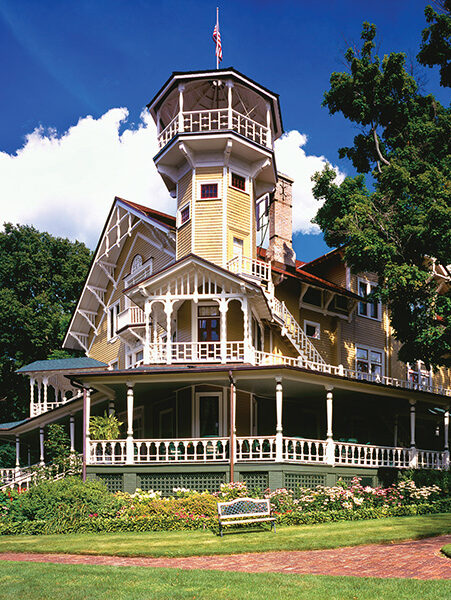
Get the Best Deal in History
Wisconsin Historical Society members receive unlimited free admission to our 11 historic sites and museums, a complimentary annual subscription to the Wisconsin Magazine of History, merchandise discounts and more. Join at the Family level and above for added benefits and discounts at over 1,200 organizations nationwide!

Take a Cruise to the Victorian Summer Retreat of a Chicago Beer Baron
Black Point Estate was built for Chicago Beer Baron Conrad Seipp in 1888 as a retreat, and in that spirit the home remains a place to relax, refresh, and explore. Just like the Victorian VIPs who established the estate, you’ll arrive in style and enjoy stunning Geneva Lake views on your cruise to this magnificent mansion, considered one of the finest examples of period architecture and furniture in the Midwest, and one of the oldest homes in Lake Geneva.
MARK YOUR CALENDAR

Members Get Free Admission!
Become a Wisconsin Historical Society member and visit all 12 of our historic sites for free! Membership pays for itself in as little as two visits and includes other great benefits like discounts and reciprocal benefits to more than 1,200 organizations.






Black Point Estate and Gardens
Historic House Museum.
We appreciate the coverage from the Lake Geneva Regional News and Resorter ... See MoreSee Less
Black Point Estate and Gardens opens for the season on May 4
lakegenevanews.net
Black Point Estate and Gardens opens for the season on May 4, offering a full roster of experiences and event from May through October.Comment on Facebook
In the summer of 2023, interns Maria Dickfoss and Kyreland (Kiki) Nolan interviewed more than forty Black Point volunteers and staff members. We will be sharing one of those interviews each week during 2024.
Next up is Ruth Monico
How long have you worked at Black Point?
This is my 7th year.
What connected you to Black Point?
I went to a beer tasting in Lake Geneva with my husband and on the table was flyer recruiting new volunteers and staff. I showed my husband and was like, “I’m there! I want to try out for this.”
What did you do before working here?
I’ve been retired since 2014, but I was a dietitian and the food service director in various nursing homes. I also substitute taught after I retired because I was a former teacher and enjoyed it. Now I have two volunteer jobs and I work here. I work for the food pantry in Lake Geneva and the clothing outreach center in Elkhorn.
How long have you been connected to the area?
Since 1950. My parents had a summer home in Williams Bay since 1950, and then they bought a couple house in Williams Bay over the years. We lived in one and sold that and lived in anther and then they bought a house in 1960 and I’ve been up here since then but only in the summer and ironically my maiden name is Summer. And then we moved up here permanently when Covid started.
What is your favorite story or artifact in the house?
The boat things that are left in the billiard room. The boiler cover on the dining porch. I'm just fascinated with those old boats.
Are there any stories about Black Point that aren't well known?
Growing up we would always see all the mansions, but you can’t see Black Point. I never knew this was the home of a beer baron. I'm amazed that, for all the years I grew up here, I never knew that. We used to anchor our boats here and swim and our parents would let us go for the whole day. Those are good memories. ... See MoreSee Less
Comment on Facebook
Chicago preservationists are seeking an eleventh-hour reprieve for a historic 152-year-old River North building facing imminent demolition.
The three-and-a-half story brick and cast-iron building at 720 N. Wells St., which rose from the ashes of the Great Chicago Fire with the seventh permit issued during the city’s rebuilding, is set to fall to the wrecking ball within days for redevelopment.
The building at the southwest corner of Wells and Superior streets, along with an adjacent but smaller Italianate building of similar vintage, are not designated Chicago landmarks. They are slated for demolition to make way for a four-story club designed by New York-based Robert A.M. Stern Architects that is planned for the site, according to the Chicago Planning Department.
The sturdy but ornate Wells Street corner building, which features brick above the ground floor cast iron columns and arches, is a monument to the city’s resilience in the wake of the 1871 Chicago Fire, which burned down a third of the nascent metropolis and obliterated the River North area.
The building was among the first to rise from the rubble.
Built in 1872 by Conrad Seipp, a German immigrant and prominent 19th century Chicago brewer, the first floor initially featured storefronts and the second floor housed offices. The lofty third floor was designed as a large Masonic Hall, and later repurposed as a Swedish social club. ... See MoreSee Less
Comment on Facebook
It’s as attractive as anything built in Chicago since. It must be difficult to be the architect that has to demolish it.
Masonic Halls are known to have been showcases of craftsmanship.
Please save this building!!!!
Save this building
So sad
oh dear He designed Byron Trott’s house in Winnetka 2006
I started my career a block away at 720 N Franklin Very familiar with this building Sad to see it lost Where are the hearts and souls of these developers
Please save this historic building!
View more comments